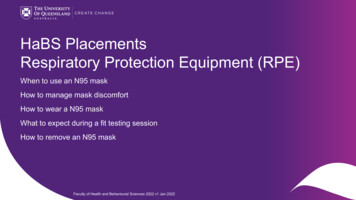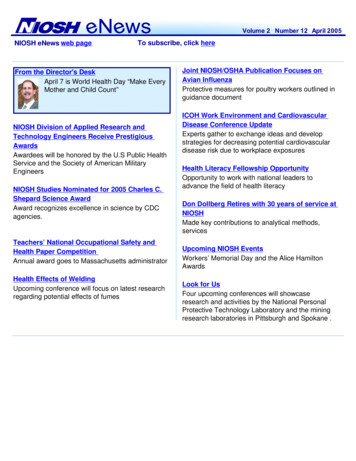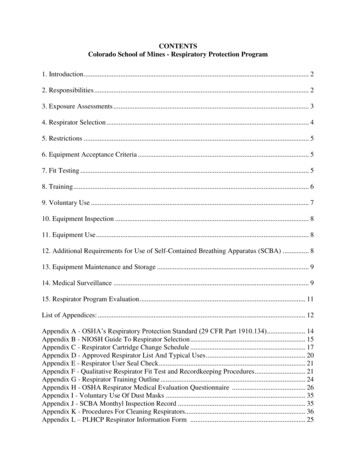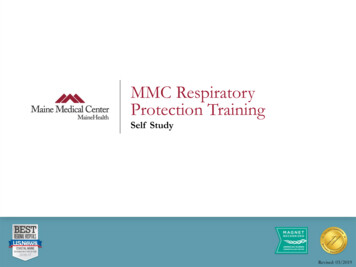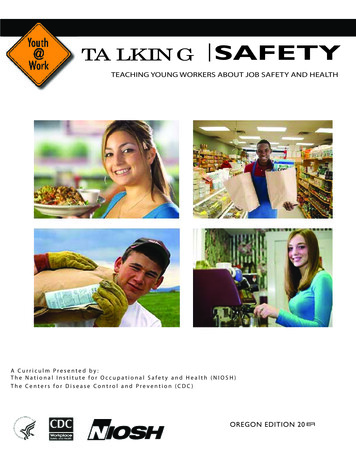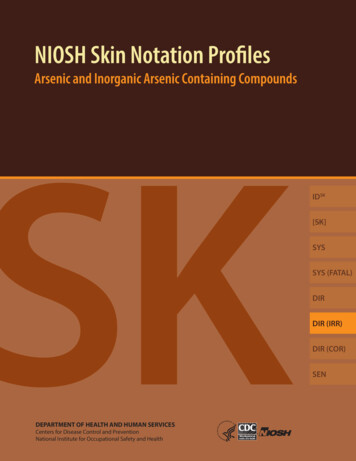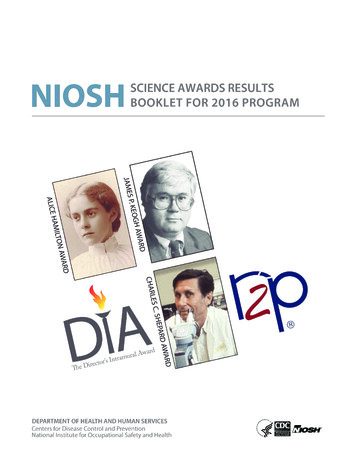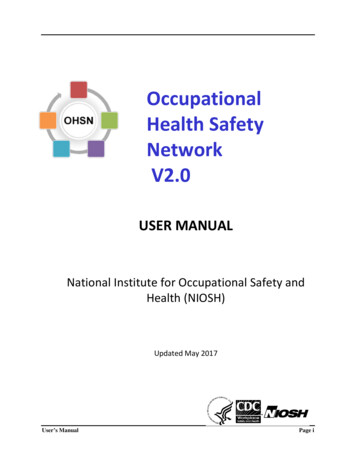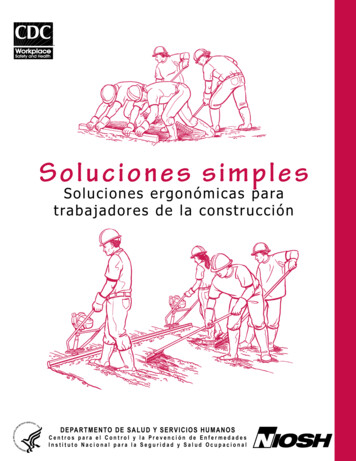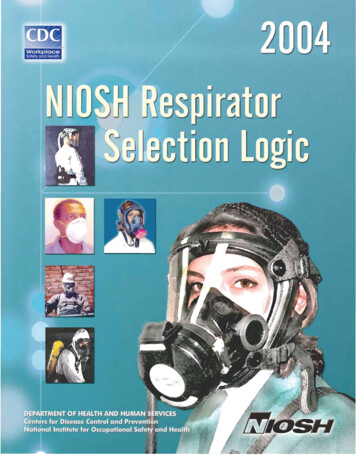
Transcription
NIOSH Respirator Selection Logic2004Author: Nancy Bollinger, M.S.U. S. Department of Health and Human ServicesCenters for Disease Control and PreventionNational Institute for Occupational Safety and HealthOctober 2004i
NIOSH Respirator Selection LogicOrdering InformationTo receive documents or other information about occupational safety and health topics,contact the National Institute for Occupational Safety and Health (NIOSH) atNIOSH Publications Dissemination4676 Columbia ParkwayCincinnati, OH 45226-1998Telephone: 1-800-35-NIOSH (1-800-356-4674)Fax: 1-513-533-8573E-mail: pubstaft@cdc.govor visit the NIOSH Web site at www.cdc.gov/nioshThis document is in the public domain and may be freely copied or reprinted.Disclaimer: Mention of any company, product, policy, or the inclusion of anyreference does not constitute endorsement by NIOSH.DHHS (NIOSH) Publication No. 2005-100ii
ForewordThe purpose of this Respirator Selection Logic (RSL) is to provide guidance torespirator program administrators on respirator selection that incorporates the changesnecessitated by the revisions to the respirator use and certification regulations andchanges in the National Institute for Occupational Safety and Health (NIOSH) policy.This RSL is not intended to be used for selection of respirators for protection againstinfectious agents or for chemical, biological, radiological or nuclear (CBRN) agents ofterrorism. While respirators can provide appropriate protection against these agents, theinformation necessary to use the selection logic is generally not available for infectiousdisease or bioterrorism agents (e.g., exposure limits, airborne concentration). Similarly,CBRN terrorism events may involve chemicals that can quickly degrade respiratormaterials or have extremely low toxic levels that are difficult to measure.In 1987, NIOSH published the NIOSH Respirator Decision Logic (RDL). Sincethen the Occupational Safety and Health Administration (OSHA) has promulgated arevision to their respirator use regulation (29CFR1910.134 published on January 8,1998), and NIOSH has promulgated the revised respirator certification standard(42CFR84 on June 8, 1995). In addition, NIOSH has revised its carcinogen policy torecommend the complete range of respirators as determined by this respirator selectionlogic for those carcinogens with quantitative recommended exposure limits (RELs).Thus, respirators can be consistently recommended regardless of whether a substance is acarcinogen or not.OSHA recently proposed a rule to establish assigned protection factors (APFs)for various classes of respirators (68FR34036 published on June 6, 2003). When theOSHA standard on APFs is finalized NIOSH intends to consider revisions to this RSL.NIOSH will also modify the certification program to assure that NIOSH certifiedrespirators will be capable of providing the level of protection determined in the OSHAAPF rulemaking. NIOSH also intends to periodically update the RSL so that it reflectscurrent OSHA requirements and NIOSH policy.Sincerely yours,John Howard, M.D.Director, National Institute for Occupational Safety andHealthCenters for Disease Control and Preventioniii
AcknowledgementsThe NIOSH Respirator Policy Group served as the internal reviewers for thisdocument. Donald Campbell and Christopher Coffey made major contributions to thisdocument through their extensive review and suggestions for revisions. NIOSH thanksHeinz Ahlers, Roland BerryAnn, Frank Hearl, Richard Metzler, Teresa Seitz, DouglasTrout and Ralph Zumwalde for their considerations and comments and Katie Musgravefor preparation of the document. NIOSH would also like to thank the external reviewersfor their comments.iv
Table of ContentsForeword . iiiI. Background and Purpose . 1II. Information and Restrictions. 2A. Criteria for Selecting Respirators. 2B. Restrictions and Requirements for All Respirator Usage . 4III. Respirator Selection Logic Sequence . 5Table 1. Particulate Respirators . 11Table 2. Gas/Vapor Respirators. 13Table 3. Combination Gas/Vapor & Particulate Respirators. 15IV. Escape Respirators. 17V. Additional Information on Hazards and Exposures. 19Subparagraph 1: Oxygen-Deficient Atmosphere. 19Subparagraph 2: Exposure Limits. 19Subparagraph 3: Immediately Dangerous to Life or Health (IDLH). 20Subparagraph 4: Eye Irritation. 21VI. Glossary of Respiratory Protection Terms . 22Appendix: NIOSH Policy Statement . 27v
I. Background and PurposeThe purpose of this respirator selection logic (RSL) is to provide a process that respiratorprogram administrators can use to select appropriate respirators for the protection ofworkers in specific workplaces. It is not intended to be used for selection of respiratorsfor protection against infectious agents or chemical, biological, radiological or nuclear(CBRN) exposures associated with terrorism events.*This RSL contains a series of questions regarding situations which may require the use ofrespirators. (See Respirator Selection Logic Sequence, page 5.) In answering thesequestions, the user of this selection logic is assisted in identifying specific classes ofrespirators, applicable restrictions, and the appropriate respirator selection table to use.When using one of the tables to identify a suitable class of respirators, the user must keepin mind the restrictions identified in the question section of this respirator selection logic.This RSL identifies the criteria necessary to determine the classes of respirators that willprovide the minimum acceptable degree of protection for a chemical at a givenconcentration. Classes of respirators offering greater protection can usually be used inplace of the minimum acceptable class of respirators. Respirator classes are consistentwith respirator certification groupings as specified in 42 CFR 84.The recommendations in this RSL are based primarily on the physical, chemical, andtoxicologic properties of the contaminant and on the limitations of each class ofrespirator, including filtration efficiency, air supply capability, and face sealcharacteristics and leakage. Thus, this selection logic is limited to identifying classes ofacceptable respirators, rather than individual respirator models.After various classes of respirators are identified as being suitable for a given situation,an evaluation is made of other factors of the particular work environment (e.g., job, task,temperature, mobility, etc.) so that the most appropriate respirator model within therecommended classes can be chosen. In some situations, the selection of a respiratorclassified as providing a higher level of protection may be advisable.The assigned protection factors (APFs) used in this respirator selection logic were basedon quantitative fit factor data developed by Los Alamos National Laboratories undercontract to NIOSH and on field and laboratory data gathered by NIOSH and others. ANotice of Proposed Rulemaking on Assigned Protection Factors was published by OSHAon June 6, 2003. When this regulation is finalized, NIOSH will consider the newstandard and revise the RSL as necessary. NIOSH will also modify its certification*Note: Selection of respirators for infectious disease and terrorism-related exposuresrequires consideration of additional factors in addition to the traditional exposureassessment approaches described in this guidance. See the NIOSH respirator topic pagehttp://www.cdc.gov/niosh/topics/respirators/ for additional information and guidance onparticular infectious disease and terrorism issues.1
program to assure that NIOSH certified respirators will be capable of providing the levelof protection determined in the OSHA APF rulemaking. Fit factors determined for theindividual wearer of a respirator by quantitative fit testing or by any other method used todetermine fit should not be substituted for the APF given for each class of respirators. Inaddition, the fit factor determined through quantitative fit testing must be greater than theAPF (10X the APF is generally recommended); otherwise, the respirator cannot be usedby the worker.Note: In order to provide protection at the APF level, respirators must be used in acomplete respirator program such as the one required by OSHA in 29CFR1910.134.II. Information and RestrictionsA. Criteria for Selecting RespiratorsTo use this selection logic, the user must first assemble the necessary toxicologic, safety,and other relevant information for each respiratory hazard, including the following: General use conditions, including determination of contaminant(s); Physical, chemical, and toxicological properties of the contaminant(s); NIOSH recommended exposure limit (REL), OSHA permissible exposure limit(PEL), American Conference of Governmental Industrial Hygienists (ACGIH)Threshold Limit Value (TLV), State-OSHA exposure limit, AmericanIndustrial Hygiene Association (AIHA) Workplace Environmental ExposureLimit (WEEL), or other applicable occupational exposure limit; Expected concentration of each respiratory hazard; Immediately dangerous to life or health (IDLH) concentration; Oxygen concentration or expected oxygen concentration; Eye irritation potential; and Environmental factors, such as presence of oil aerosolsNIOSH recommends that air sampling be conducted to determine exposure levels foundin the workplace. A combination of air sampling and exposure modeling is often used tomake reasonable estimates of exposure. Ideally, this determination should be made by aprofessional industrial hygienist. Also, OSHA offers free consultation to qualifyingsmall- and medium-sized businesses to help recognize hazards, suggest approaches tosolving problems and identifying the kinds of help available if further assistance isrequired. The OSHA website www.osha.gov provides information on complianceassistance and consultation programs.2
Obtaining complete information on all criteria needed to use this selection logic may bedifficult. When conflicting or inadequate data are found, experts should be consultedbefore decisions are made that could affect the proper use of this selection logic. Inaddition, the adequacy of the respirator selected is dependent on the validity of theexposure limit used and the accuracy of the hazard concentration determination. Whilethe selection logic can be used with any exposure limit, NIOSH recommends that themore protective limit of the NIOSH REL or the OSHA PEL, be used in respiratorselection. If no REL or PEL exists, other applicable occupational exposure limits such asthe ACGIH TLV can be used.The information obtained on general use conditions for respirators should include adescription of the actual job task, including the duration and frequency, location, physicaldemands, and industrial processes, as well as issues affecting the comfort of therespirators. Some conditions may preclude the use of specific types of respirators incertain circumstances because the individual must be medically and psychologicallysuited (i.e., not claustrophobic) to wear a given respirator for a given task, particularly ifthe respirator is a self-contained breathing apparatus (SCBA).Employers must establish a cartridge/canister changeout schedule which is based on theservice life of the cartridge/canister under the conditions of use. The changeout schedulecan be determined with the assistance of the respirator manufacturer (changeout softwareor other tools) or by conducting service life tests. Information obtained on the service lifeof the cartridge/canister under conditions of intended use must be evaluated regardless ofthe odor warning properties of the chemicals. These evaluations must be based on allgases and vapors present at the temperature and relative humidity extremes (high andlow) in the workplace. NIOSH recommends that when the employer or a representativeof the employer conducts service life tests, the challenge concentrations of the gases andvapors should be at least the maximum use concentration (MUC) of the respirator andthat a safety margin be applied when evaluating service life data. OSHA providesinformation on determining change schedules on their e-schedules.html). In humid workplaceswhere organic vapor cartridges are used to protect workers from a single volatile source,software (CD-ROM) for predicting service life can be ordered from NIOSH by calling 1800-356-4674. The software can also be downloaded from the OSHA website isor genius wood/breakthrough.html.This information can be used to set up cartridge replacement schedules and should beused in conjunction with sensory warning properties.Although odor should not be relied on for cartridge/canister change out, workers shouldbe trained to exit the contaminated area whenever they detect the odor or experience anyirritation symptoms of the contaminant. (See the NIOSH policy statement dated August4, 1999, in the Appendix (page 27) for a discussion of the OSHA standard and NIOSH’srecommendations for change schedules.) If workers are detecting the odor before the endof the change schedule, the respirator program administrator should reevaluate thisrespirator use; i.e., the change schedule, the workplace concentrations or the other useconditions (relative humidity (RH), work rate, etc.).3
B. Restrictions and Requirements for All Respirator UsageThe following requirements and restrictions must be considered to ensure that therespirator selected will provide adequate protection under the conditions of intended use:1. Workers are not exposed to a single unvarying concentration of a hazardoussubstance, rather, individual exposures may vary throughout a workshift and betweendays. The highest anticipated concentration should therefore be used to compute therequired protection factor for each respirator wearer.2. Qualitative or quantitative fit tests must be provided as appropriate to ensure that thetight-fitting facepiece respirator fits the individual. NIOSH endorses the OSHAstandard 29 CFR1910.134 for fit testing except for irritant smoke (see the Appendix,page 27). Employees must pass a fit test with the exact model and size that they willwear in the workplace.3. Respirators with tight-fitting facepieces should not be used when facial scars ordeformities interfere with the face seal.4. Respirators with tight-fitting facepieces (including pressure-demand respirators)should not be used when facial hair interferes with the face seal.5. The usage limitations of air-purifying elements, particularly gas and vapor cartridgesor canisters, should not be exceeded (see NIOSH Certified Equipment List for generallimitations at cel).6. Respirators must be certified by the NIOSH. A list of certified respirators can befound at http://www.cdc.gov/niosh/celintro.html.7. A complete written respiratory protection program must be developed whichincludes regular worker training; maintenance, inspection, cleaning, and evaluation ofthe respirator; use of the respirator in accordance with the manufacturer’s instructions;fit testing; medical evaluation; and environmental monitoring. Minimum respiratoryprotection requirements for some contaminants can be found in the OSHA RespirationProtection Standards, 29 CFR 1910.134. Detailed information on respirator programscan be accessed at: http://www.osha.gov/SLTC/etools/respiratory. In addition, theOSHA Small Entity Compliance Guide provides procedures and checklists that canhelp small businesses comply with the respirator standard. This information can beaccessed at: http://www.osha.gov/Publications/SECG RPS/secgrev-current.pdf.8. The APFs that appear in this respirator selection logic are based for the most part onlaboratory studies. However, a few APFs have been validated and revised as necessaryafter consideration of data obtained from studies of workplace protection factors(WPFs). OSHA is currently considering setting APFs for respirators.4
III. Respirator Selection Logic SequenceAfter all criteria have been identified and evaluated and after the requirements andrestrictions of the respiratory protection program have been met, the following sequenceof questions can be used to identify the class of respirators that should provide adequaterespiratory protection. Note that if OSHA has promulgated a substance – specificstandard for a contaminant found in your workplace, respirator selection must meet orexceed the respirators required in that standard. (OSHA General Industry AirContaminants Standard, 29 CFR 1910.1000).Step 1. Is the respirator intended for use during fire fighting?a. If yes, only a full-facepiece, pressure-demand, self-contained breathingapparatus (SCBA) meeting the requirement of the NFPA 1981, Standard onOpen-circuit Self-contained Breathing Apparatus for Fire and EmergencyServices (2002 edition) is required. Information on NFPA 1981 can be found athttp://www.nfpa.org.b. If no, proceed to Step 2.Step 2. Is the respirator intended for use in an oxygen-deficient atmosphere, i.e.,less than 19.5% oxygen?a. If yes, any type of SCBA other than escape only, or supplied-airrespirator (SAR) with an auxiliary SCBA is required. Auxiliary SCBAmust be of sufficient duration to permit escape to safety if the air supply isinterrupted.If yes, and contaminants are also present, proceed to Step 3 to determine ifthe hazard requires the SCBA or SAR/SCBA to meet a specific APF level.b. If no, proceed to Step 3.Step 3. Is the respirator intended for entry into unknown or IDLH atmospheres (e.g., anemergency situation)?a. If yes, one of two types of respirators are required: a pressuredemand SCBA with a full facepiece or a pressure-demand SAR with afull facepiece in combination with an auxiliary pressure-demand SCBA.Auxiliary SCBA must be of sufficient duration to permit escape to safety ifthe air supply is interrupted.b. If no, proceed to Step 4.Step 4. Is the exposure concentration of the contaminants, as determined byacceptable industrial hygiene methods, less than the NIOSH REL or otherapplicable exposure limit?5
a. If yes, a respirator is not required for routine work. For escaperespirators, determine the potential for generation of a hazardous conditioncaused by an accident, spill or equipment failure. See Section IV. Page 17,for a discussion and selection of escape respirators. Proceed to Step 6.*b. If no, proceed to Step 5.* If respirators are required by the employer to be worn (even if below theoccupational exposure limit), OSHA requires that the employer establishand implement a written respiratory protection program with worksitespecific procedures. If an employer provides respirators at the request ofemployees or permits employees to use their own respirators when exposurelevels are below the applicable limits, this is considered voluntaryrespirator use. OSHA requires that employers provide to their employeesthe information contained in Appendix D of 29 CFR 1910.134, that theyestablish and implement those elements of a written program necessary toensure that any employee using a respirator voluntarily is medically ableto wear the respirator (except that medical evaluation is not required forvoluntary use of filtering facepieces) and that the respirator is cleaned,stored, and maintained so that it does not represent a health hazard to thewearer.Step 5. Are conditions such that a worker who is required to wear a respirator canescape from the work area and not suffer loss of life or immediate or delayedirreversible health effects if the respirator fails, i.e., are the conditions not immediatelydangerous to life or health (IDLH)? IDLH values for certain compounds can befound in the NIOSH Pocket Guide for Chemical Hazards. This document can beaccessed at http://www.cdc.gov/niosh/npg/npg.html. IDLH values for somesubstances can also be found on the NIOSH internet athttp://www.cdc.gov/niosh/idlh/idlh-1.html.a. If yes, conditions are not considered to be IDLH. Proceed to Step 6.b. If no, conditions are considered to be IDLH. Two types of respirators arerecommended: a pressure-demand, full-facepiece SCBA or a pressuredemand, full-facepiece SAR in combination with an auxiliary pressuredemand, full-facepiece SCBA. The auxiliary SCBA must be of sufficientduration to permit escape to safety if the air supply is interrupted. An auxiliaryunit means that the SAR unit includes a separate air bottle to provide a reservesource of air should the airline become damaged. The auxiliary unit shares thesame mask and regulator, and enables the SAR to function as an SCBA ifneeded.Step 6. Is the contaminant an eye irritant, or can the contaminant cause eyedamage at the workplace concentration? Information on eye irritation is included6
in the International Programme on Chemical Safety, International ChemicalSafety Cards which can be accessed athttp://www.cdc.gov/niosh/ipcs/nicstart.html.a. If yes, a respirator equipped with a full facepiece, helmet, or hood isrecommended. Proceed to Step 7.b. If no, a half-mask or quarter-mask respirator may still be an option,depending on the exposure concentration. Proceed to Step 7.Step 7. Determine the maximum hazard ratio (HR) by the following: Divide the time-weighted average (TWA) exposureconcentration for the contaminant determined in Step 4 by theNIOSH REL or other applicable exposure limit. If the exposurelimit is an 8 hour limit the TWA used must be on 8 hour average.If the exposure limit is based on 10 hours, use a 10 hour TWA. If the contaminant has a ceiling limit, divide the maximumexposure concentration for the contaminant determined in Step 4by the ceiling limit. If the contaminant has a short term exposure limit (STEL),divide the maximum 15 min TWA exposure concentration for thecontaminant determined in Step 4 by the STEL. For escape respirators, determine the potential forgeneration of a hazardous condition caused by an accident orequipment failure. If a potentially hazardous condition could occur or a hazardratio greater than 1 has been calculated, proceed to Step 8.Step 8. If the physical state of the contaminant is: a particulate (solid or liquid aerosol) during periods of respirator use,proceed to Step 9; a gas or vapor, proceed to Step 10; a combination of gas or vapor and particulate, proceed to Step 11.Step 9. Particulate Respirators9.1. Is the particulate respirator intended only for escape purposes?7
a. If yes, see Section IV (page 17), for a discussion and selection ofescape respirators.b. If no, the particulate respirator is intended for use during normal workactivities. Proceed to Step 9.2.9.2. A filter series (N, R or P) that will provide protection against exposure to theparticulate in question is recommended.a. The selection of N-, R-, and P-series filters depends on thepresence or absence of oil particles, as follows: If no oil particles are present in the work environment, use afilter of any series (i.e., N-, R-, or P-series). If oil particles (e.g., lubricants, cutting fluids, glycerine, etc.)are present, use an R- or P-series filter. Note: N-series filterscannot be used if oil particles are present. If oil particles are present and the filter is to be used for morethan one work shift, use only a P-series filter.Note: To help you remember the filter series, use the following guide:N for Not resistant to oil,R for Resistant to oilP for oil Proofb. Selection of filter efficiency (i.e., 95%, 99%, or 99.97%) depends onhow much filter leakage can be accepted. Higher filter efficiency meanslower filter leakage.Additional information on selecting the appropriate filter certifiedunder 42CFR84 can be found athttp://www.cdc.gov/NIOSH/userguid.html. Proceed to Step 9.3.9.3. Respirators that have not been eliminated from Table 1 by the previous stepsand that have APFs equal to, or greater than, the maximum hazard ratio determined inStep 7 are recommended. 1 Note, however, that the maximum useconcentration (MUC) is the maximum atmospheric concentration of ahazardous substance from which an employee can be expected to beprotected by a class of respirator and is determined by the lesser of: APF X exposure limit The respirator manufacturer’s MUC for a hazardous substance(if any)1If the respirator is intended for use in an oxygen-deficient atmosphere, only SCBA or SAR with anauxiliary SCBA, can be selected from the Table.8
The IDLH, unless the respirator is a pressure-demand, fullfacepiece SCBA or combination pressure-demand SAR with a fullfacepiece in combination with an auxiliary pressure-demandSCBA.For multi-component mixtures the MUC can be calculated by:C 1 /MUC 1 C 2 /MUC 2 C n /MUC n 1Step 10. Gas/Vapor Respirators10.1. Is the gas/vapor respirator intended only for escape?a. If yes, refer to escape respirators Section IV (page 17).b. If no, the gas/vapor respirator is intended for use during normal workactivities. Proceed to Step 10.2.10.2. An air-purifying chemical cartridge/canister respirator is recommendedthat has a sorbent suitable for the chemical properties of the anticipatedgas/vapor contaminant(s) and for the anticipated exposure levels.Information on cartridges or canisters approved for use for classes ofchemicals or for specific gases or vapors can be found in the NIOSHCertified Equipment ors/cel/. Proceed to Step10.3.10.3. Respirators that have not been eliminated from Table 2 by the previoussteps and that have APFs equal to, or greater than, the maximum hazard ratiodetermined in Step 7 are recommended.1 Note, however, that the maximumuse concentration (MUC) is the maximum atmospheric concentration of ahazardous substance from which an employee can be expected to be protectedby a class of respirator and is determined by the lesser of: APF X exposure limit The respirator manufacturer’s MUC for a hazardous substance(if any) The IDLH, unless the respirator is a pressure-demand, fullfacepiece SCBA or combination pressure-demand SAR with a fullfacepiece in combination with an auxiliary pressure-demandSCBA.For multi-component mixtures the MUC can be calculated by:C 1 /MUC 1 C 2 /MUC 2 C n /MUC n 11If the respirator is intended for use in an oxygen-deficient atmosphere, only SCBA or SAR with anauxiliary SCBA, can be selected from the Table.9
Step 11. Combination Particulate and Gas/Vapor Respirators11.1. Is the combination respirator intended for "escape only" purposes?a. If yes, refer to escape respirators on page 17, for a discussion andselection of "escape only" respirators.b. If no, the combination respirator is intended for use during normal workactivities. Proceed to Step 11.2.11.2 From Table 3, select a respirator type, not eliminated by the previous steps,and have APFs equal to, or greater than, the maximum hazard ratio determined inStep 7. are recommended. 1 Note, however, that the maximum useconcentration (MUC) is the maximum atmospheric concentration of ahazardous substance from which an employee can be expected to beprotected by a class of respirator and is determined by the lesser of: APF X exposure limit The respirator manufacturer’s MUC for a hazardous substance(if any) The IDLH, unless the respirator is a pressure-demand, fullfacepiece SCBA or combination pressure-demand SAR with a fullfacepiece in combination with an auxiliary pressure-demandSCBA.For multi-component mixtures the MUC can be calculated by:C 1 /MUC 1 C 2 /MUC 2 C n /MUC n 11If the respirator is intended for use in an oxygen-deficient atmosphere, only SCBA or SAR with anauxiliary SCBA, can be selected from the Table.10
Table 1. Particulate RespiratorsAssigned protection1factor510Type of RespiratorQuarter mask respiratorAny air-purifying elastomeric half-mask respirator equipped withappropriate type of particulate filter.2Appropriate filtering facepiece respirator.2,3Any air-purifying full facepiece respirator equipped withappropriate type of particulate filter.22550Any negative pressure (demand) supplied-air respirator equippedwith a half-mask.Any powered air-purifying respirator equipped with a hood orhelmet and a high efficiency (HEPA) filter.Any continuous flow supplied-air respirator equipped with a hoodor helmet.Any air-purifying full facepiece respirator equipped with N-100,R-100, or P-100 filter(s).Any powered air-purifying respirator equipped with a tight-fittingfacepiece (half or full facepiece) and a high-efficiency filter.Any negative pressure (demand) supplied-air respirator equippedwith a full facepiece.Any continuous flow supplied-air respirator equipped with a tightfitting facepiece (half or full facepiece).Any negative pressure (demand) self-contained respirator equippedwith a fu
then the Occupational Safety and Health Administration (OSHA) has promulgated a revision to their respirator use regulation (29CFR1910.134 published on January 8, 1998), and NIOSH has promulgated the revised respirator certification standard (42CFR84 on June 8, 1995). In addition, NIOSH has revised its carcinogen policy to
